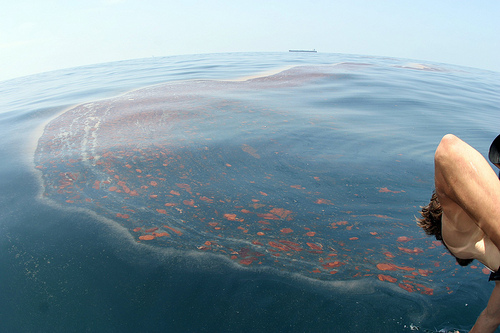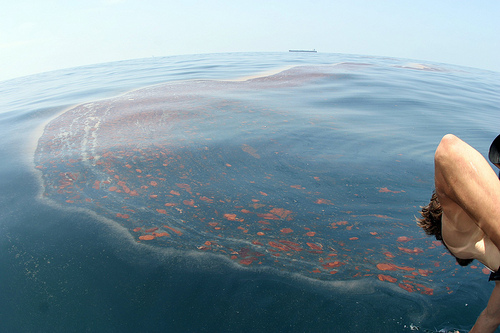 “Eww.” A toxic-smelling trail of “dispersed” oil in the Gulf.Photo: National Wildlife FederationDown $350 million so far and its much-hyped containment dome done in by clumps of icy slush, BP is mulling other options to shut off the gushing oil spill in the Gulf of Mexico. It might try again with a smaller dome. Or it might go all high-techy and shoot shredded tires and golf balls into the spewing pipes. No, really.
“Eww.” A toxic-smelling trail of “dispersed” oil in the Gulf.Photo: National Wildlife FederationDown $350 million so far and its much-hyped containment dome done in by clumps of icy slush, BP is mulling other options to shut off the gushing oil spill in the Gulf of Mexico. It might try again with a smaller dome. Or it might go all high-techy and shoot shredded tires and golf balls into the spewing pipes. No, really.
“The next tactic is going to be something they call a junk shot,” Admiral Thad Allen, commandant of the U.S. Coast Guard, told CBS’s Face the Nation on Sunday. “They’ll take a bunch of debris — shredded up tires, golf balls, and things like that — and under very high pressure, shoot it into the preventer itself and see if they can clog it up and stop the leak.”
Now that we’ve reached the tragic farce level on this disaster, more and more questions are being raised about how we got here.
One big contributor: When it comes to safety, BP seems more Homer Simpson than Ned Flanders. The New York Times‘ Jad Mouawad writes:
Despite … repeated promises to reform, BP continues to lag other oil companies when it comes to safety, according to federal officials and industry analysts. Many problems still afflict its operations in Texas and Alaska, they say.
Plus, Transocean, the company that owned the collapsed rig, has its own safety issues. In fact, according to Ben Casselman writing for The Wall Street Journal, “Nearly three of every four incidents that triggered federal investigations into safety and other problems on deepwater drilling rigs in the Gulf of Mexico since 2008 have been on rigs operated by Transocean.”
Meanwhile, Jim Tankersley and Julie Hart of the Los Angeles Times point to the failure of government regulators, specifically the Interior Department’s Minerals Management Service, to keep up with the oil industry as offshore drilling has become more complex and untested.
MMS calculates the risk of a major spill based on historical precedent, even as gulf drilling moves into unprecedented depths. Because of that, the assessments don’t accurately reflect new challenges of drilling for oil far from equipment and support, to depths inhospitable to divers, where extremes of pressures and temperatures can tax materials such as cements used to fix casings, or synthetic materials used for seals and valves.
We know one thing that didn’t get us into this mess: eco-saboteurs. Right-wing chirping about plots and conspiracies has been discredited. BP’s oil rig, according to crew members who witnessed the explosion, was done in by one big gas bubble, as Joel Achenbach details in The Washington Post.
And no, the Gulf spill doesn’t qualify as “Obama’s Katrina.” A narrative pulled together by The Associated Press shows that the White House was on the case, particularly when it became clear that the wreckage had sprung a leak.
Instead, argues New York Times columnist Paul Krugman, at least part of the blame for this mess should be laid at the feet of the man who first “pulled a Katrina.”
[T]he Bush administration was, to a large degree, run by and for the extractive industries — and I’m not just talking about Dick Cheney’s energy task force. Crucially, management of Interior was turned over to lobbyists, most notably J. Steven Griles, a coal-industry lobbyist who became deputy secretary and effectively ran the department.



